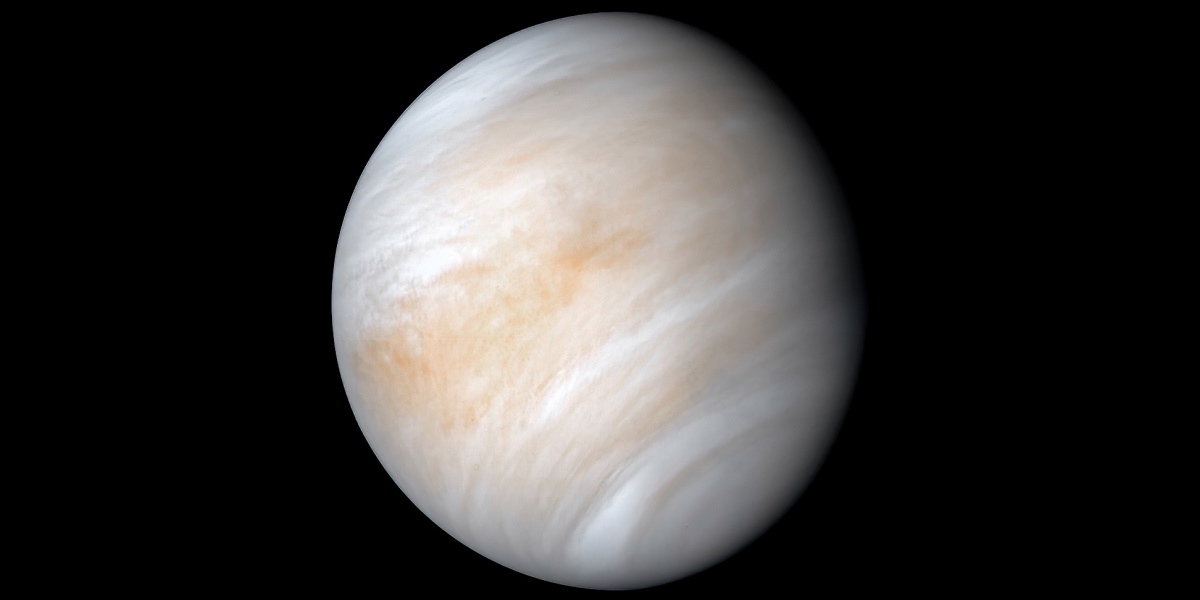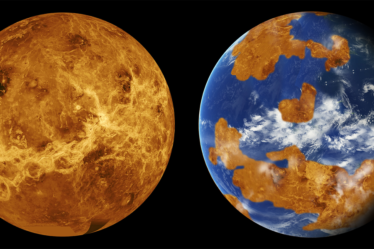
Venus has long played second fiddle to its redder, smaller, and more distant sibling. Given how inhospitable we’ve learned Venus to be, we’ve spent the majority of the last century pinning some of our biggest hopes of finding signs of extraterrestrial life on Mars.
That all changed this week.
On Monday it was announced that a peculiar gas called phosphine had been spotted in the clouds above Venus. The gas is produced by microbes here on Earth, and after most known nonbiological processes were ruled out, the discovery has renewed hopes that there’s life on Venus. Now we need to know for sure.
“To really get at the heart of this question, we need to go to Venus,” says Paul Byrne, a planetary scientist at North Carolina State University and a self-professed “Venus evangelical.” In fact, it might be time to think not just about what the next mission to Venus should be, but what a whole new era of Venus exploration would look like: a fleet of multiple missions that explore Venus in concert the way we currently do with Mars.
There is, after all, only so much you can do with ground-based instruments. “Venus is extremely bright, and many of the large ground-based telescopes cannot properly observe it,” says Sara Seager, an MIT astronomer and one of the coauthors of the new phosphine study. This brightness, caused by the intense reflection of sunlight from its thick clouds and highlighted by its close proximity to Earth, basically blinds our instruments from making detailed observations of the planet. It’s like trying to look at the road while another car’s high beams are pointed in your direction. Space-based telescopes may fare better, but Seager says it’s still too early to tell whether they will suffer from the same problem.
And while telescopes on Earth can detect traces of phosphine and other gases of interest, there’s no way to actually suss out whether they are produced by life or some other exotic chemistry, like volcanism. While Seager and her team have thoroughly ruled out known natural causes for phosphine on Venus, the planet could very well be home to geochemistry we’ve never thought possible. Answering these questions and fully ruling out natural explanations means we need to get up close.
So let’s go to Venus!
Of course, that’s easier said than done. Temperatures at the surface reach a scorching 464 °C, and pressures are 89 times higher than on Earth. Only the Soviet Union has successfully landed on the Venusian surface—its Venera 13 lander functioned for 127 minutes before succumbing to the elements in 1982. It’s not easy to justify spending hundreds of millions or even billions of dollars on a mission that could be over in a matter of hours and not give us what we need.
So an orbiter is the most sensible start. Unlike ground-based observations, orbiters can peer into the atmosphere and would have a better time observing how phosphine or other potential biosignatures change over time or over what regions they are most concentrated. Humans have experience with such missions. The last major Venus orbiter was ESA’s Venus Express, which studied Venus for eight years until engineers lost contact with it, likely because it ran out of fuel. Currently, the only spacecraft exploring Venus is Japan’s Akatsuki orbiter, which arrived in 2015 to study the planet’s climate and weather. It’s doing good science, but it doesn’t have any instruments that could really probe atmospheric chemistry and look for signs of organic life.
An orbiter also presents the opportunity to pull off more daring projects and venture directly into the clouds. A sample return mission could be possible, in which a spacecraft flies into the atmosphere and bottles up some gas to bring back to Earth for laboratory analysis. Byrne notes that lots of proposals over the years have called for dropping something into the atmosphere itself to look for more biosignatures or even organic matter. To keep such a platform in the air for as long as possible (potentially weeks or months at a time), engineers have proposed slowing down its descent using balloons or rotors.
Tough choices
Trying to find life on another planet, however, isn’t simply a walk from point A to point B. No single mission to Venus will be able to pull off all the work necessary to answer the question. NASA already has two prospective Venus missions in the works. DAVINCI+ is a probe that would plunge straight into Venus’s atmosphere and study its chemical composition using multiple spectrometers over the course of a 63-minute descent. VERITAS is an orbiter that would use a combination of radar and near-infrared spectroscopy to peer beyond the planet’s thick clouds and help us understand the surface geology and topography. Past research suggests the planet may have active volcanism and may have once been home to shallow oceans, but the inability to map the surface optically has made it impossible to verify these theories so far.
Each mission could turn up interesting new clues that get us closer to determining whether there is life there, but neither would be able to answer that question on its own. When it comes to phosphine, for instance, DAVINCI+ might get lucky enough to determine what parts of the atmosphere this gas is concentrated in. But if it is being produced on the surface, the probe won’t necessarily have the tools to identify the location. VERITAS might find the site of strange geochemistry, but without actually sampling the phosphine directly in the clouds, there wouldn’t be enough evidence to connect the two mysteries.
Think big
Byrne is bullish about wanting to see a comprehensive exploration program for Venus similar to what we’ve already seen for Mars. On that planet, there are orbiters imaging the landscape, measuring atmospheric escape and chemistry, and surveying the weather. There are rovers tasked with understanding organics on the ground and looking for signs of life. There are landers looking at the interior geology and measuring the planet’s seismic activity.
Imagine a similar program on Venus, with multiple missions running at the same time. Under such a program, both VERITAS and DAVINCI+ would work alongside other missions to isolate biosignatures like phosphine and really see whether they are evidence of extant life or not. “I would hate to have to choose one over the other,” says Byrne. “But even if we got both, I’d still be advocating for more missions.”
These two missions (plus two others) are in the running to get the green light from NASA next April. Launch windows to Venus (when the planet is closest to Earth) come about every 19 months. If either is selected, it would not launch until 2026 at the earliest, and would take at least a few months to make the journey.
Other missions could certainly happen—and sooner. India’s space agency is debating the 2023 launch of a Venus orbiter called Shukrayaan-1 to study atmospheric chemistry. New Zealand–based Rocket Lab wants to launch a small satellite called Photon for a flyby of Venus as early as 2023. That mission would deploy a small probe into the Venusian atmosphere to collect data, although it would likely carry only one instrument, limiting the scope of any resulting research. Byrne points out that it might be worth looking into building a program out of multiple cheaper missions like Photon rather than a few very expensive ones like DAVINCI+ and VERITAS. Seager says her immediate plans are to “lead a mission concept study for an agile low-cost mission,” in collaboration with Breakthrough Initiatives (helmed by Russian billionaire Yuri Milner).
And although missions to the surface are hard to pull off, there has always been a steady stream of proposals for how to improve spacecraft engineering to make any landers last longer. One pitched by NASA scientists, called Long-Lived In-situ Solar System Exploration, calls for building electronics and hardware that can withstand Venus’s punishing environment for up to 60 days. That type of lander probably wouldn’t be ready until the next decade, however.
Even if we don’t find signs of life on Venus, that’s interesting too: it will mean Venus and Earth were two planets that started out very similarly and ended up with radically different fates. “That still raises profound questions that need answering,” says Byrne. “But to answer them, we need a program for studying the planet.”
